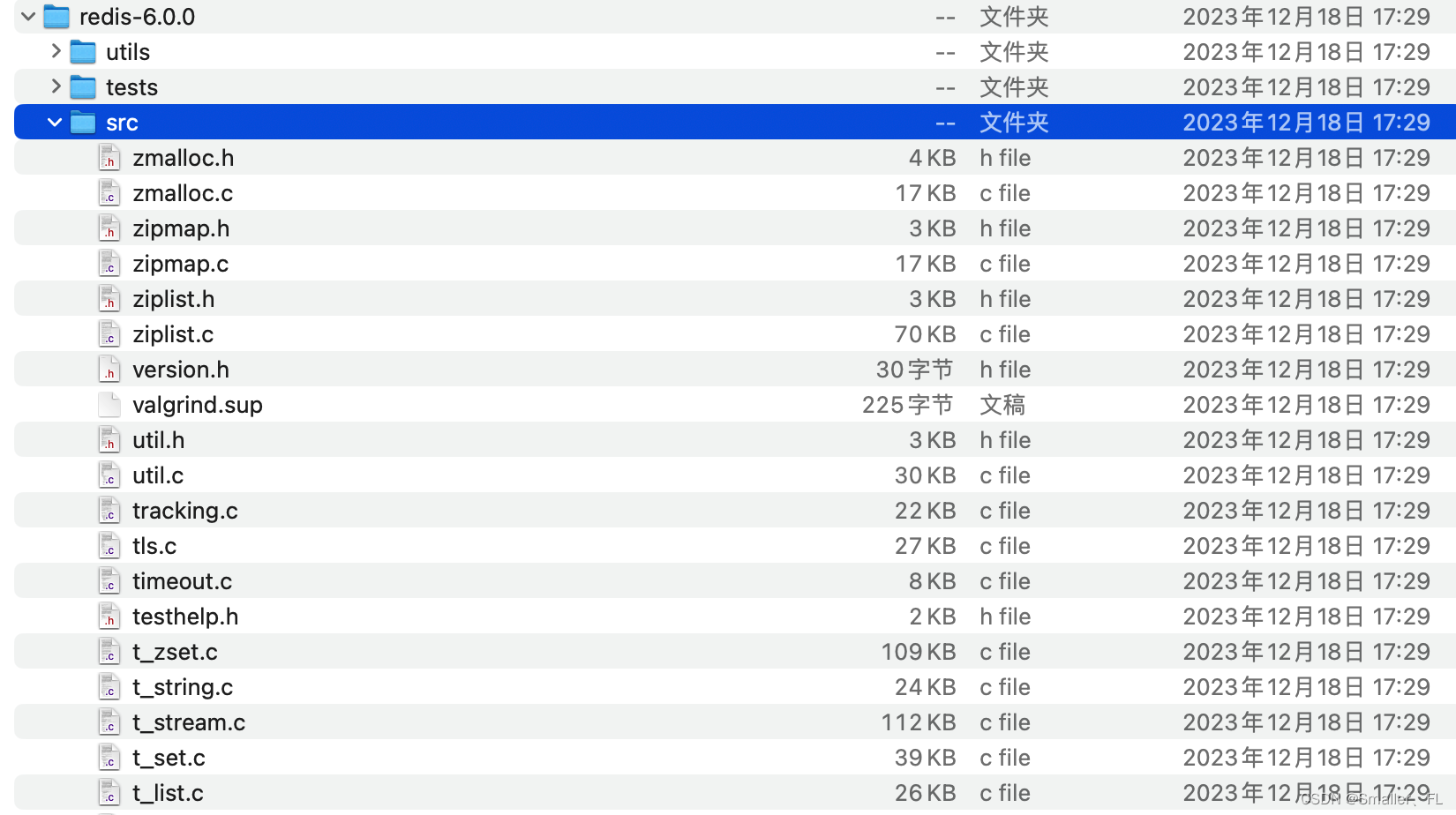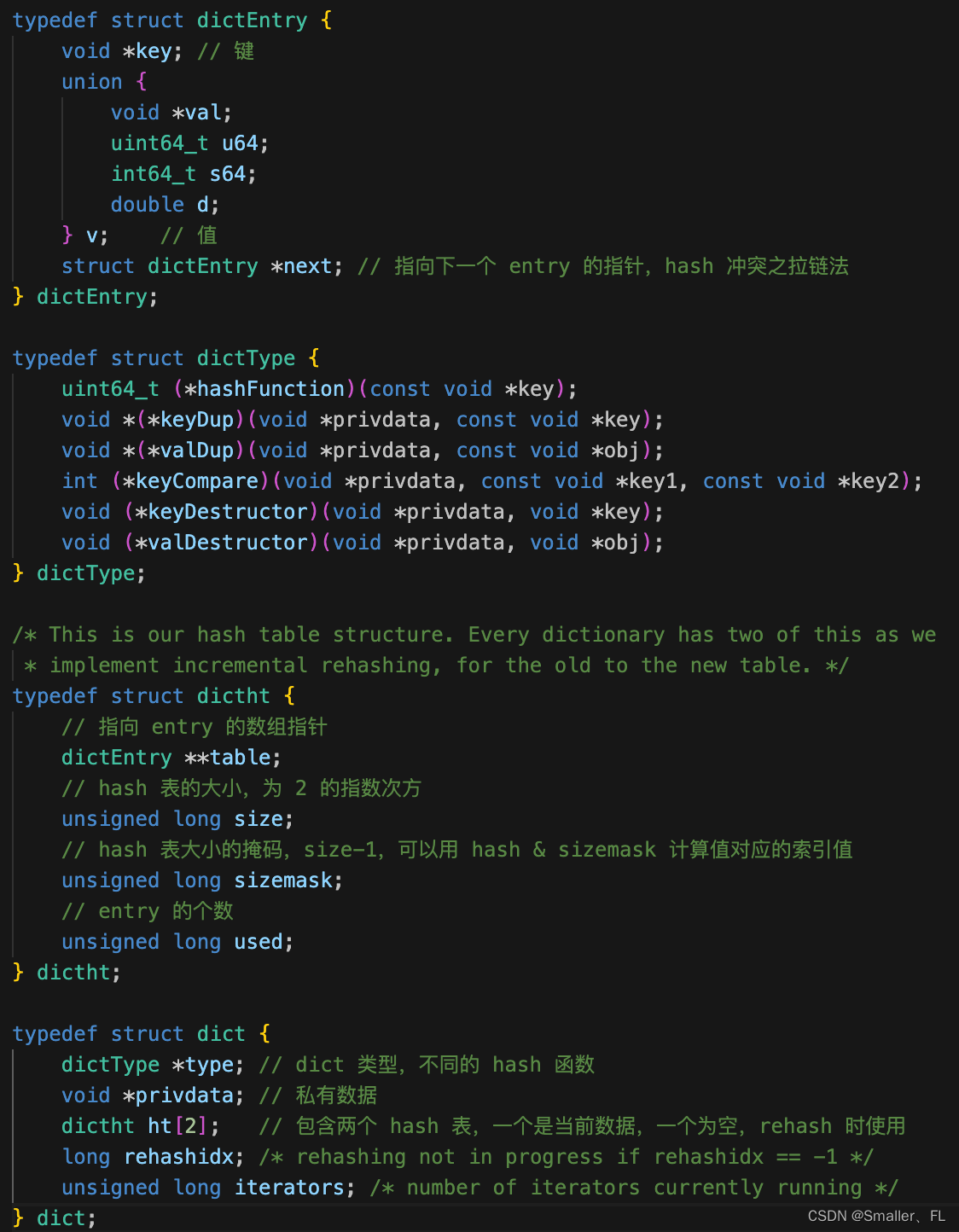1. 引言
前情提要:
《redis 从0到1完整学习 (一):安装&初识 redis》
《redis 从0到1完整学习 (二):redis 常用命令》
《redis 从0到1完整学习 (三):redis 数据结构》
《redis 从0到1完整学习 (四):字符串 SDS 数据结构》
《redis 从0到1完整学习 (五):集合 IntSet 数据结构》
本文主要结合源码来介绍 hash 表的数据结构
2. redis 源码下载
Redis 源码可以点击这里下载,方便查看其中定义的一些数据结构。

3. dict 数据结构
Dict 由三部分组成,分别是:哈希表(DictHashTable)、哈希节点(DictEntry)、字典(Dict),数据结构如下:

dict、dictht、dictEntry 三者的数据结构关系如下:

当 Dict 添加键值对时,首先由 key 计算出 hash 值 h,通过 h & sizemask (等同取模计算,提升计算速度) 计算元素对应数组中的索引位置。假设哈希值 h = 5,则 5&7=5,因此键值对存储到数组索引为5的位置。
如下图:第一次插入到下标为5的数组中。

如果第二次插入的 hash 值计算后的下标也是5,则第二次插入到链表的头部:

4. 哈希表扩容与 rehash
当哈希表中元素越来越多导致哈希冲突增多时,链表过长后,会查询效率降低,由查询的时间复杂度最开始的 O(1) 向 O(n) 移动。
这部分源码在 Redis 的好几个版本都有所变化,主要是看看扩容的条件:
(1)Redis 6.0
这里是直接判断 ht->used == ht->size。
/* Expand the hash table if needed */
static int _dictExpandIfNeeded(dict *ht) {
/* If the hash table is empty expand it to the initial size,
* if the table is "full" dobule its size. */
if (ht->size == 0)
return dictExpand(ht, DICT_HT_INITIAL_SIZE);
if (ht->used == ht->size)
return dictExpand(ht, ht->size*2);
return DICT_OK;
}
(2)Redis 6.2
引入哈希表的负载因子:LoadFactor = used/size。在每次新增键值对时都会检查负载因子。
/* Expand the hash table if needed */
static int _dictExpandIfNeeded(dict *d)
{
// 已经在 rehash, 则返回
if (dictIsRehashing(d)) return DICT_OK;
// 如果为空,则初始化 size 为4
if (d->ht[0].size == 0) return dictExpand(d, DICT_HT_INITIAL_SIZE);
// 如果负载因子 > dict_force_resize_ratio(定义为5),则扩容
if (d->ht[0].used >= d->ht[0].size &&
(dict_can_resize ||
d->ht[0].used/d->ht[0].size > dict_force_resize_ratio) &&
dictTypeExpandAllowed(d))
{
return dictExpand(d, d->ht[0].used + 1);
}
return DICT_OK;
}
(3)Redis 7.2
/* Expand the hash table if needed */
static int _dictExpandIfNeeded(dict *d)
{
/* Incremental rehashing already in progress. Return. */
if (dictIsRehashing(d)) return DICT_OK;
/* If the hash table is empty expand it to the initial size. */
if (DICTHT_SIZE(d->ht_size_exp[0]) == 0) return dictExpand(d, DICT_HT_INITIAL_SIZE);
/* If we reached the 1:1 ratio, and we are allowed to resize the hash
* table (global setting) or we should avoid it but the ratio between
* elements/buckets is over the "safe" threshold, we resize doubling
* the number of buckets. */
if (!dictTypeExpandAllowed(d))
return DICT_OK;
if ((dict_can_resize == DICT_RESIZE_ENABLE &&
d->ht_used[0] >= DICTHT_SIZE(d->ht_size_exp[0])) ||
(dict_can_resize != DICT_RESIZE_FORBID &&
d->ht_used[0] / DICTHT_SIZE(d->ht_size_exp[0]) > dict_force_resize_ratio))
{
return dictExpand(d, d->ht_used[0] + 1);
}
return DICT_OK;
}
下面以 Redis 6.2 源码介绍下扩容的核心方法_dictExpand:
/* Expand or create the hash table,
* when malloc_failed is non-NULL, it'll avoid panic if malloc fails (in which case it'll be set to 1).
* Returns DICT_OK if expand was performed, and DICT_ERR if skipped. */
int _dictExpand(dict *d, unsigned long size, int* malloc_failed)
{
if (malloc_failed) *malloc_failed = 0;
// 如果当前 size 大于要申请的 size,或者正在 rehash,则报错
if (dictIsRehashing(d) || d->ht[0].used > size)
return DICT_ERR;
dictht n; /* the new hash table */
// 初始化第一个大于等于 size 的 2^n 数,这个数赋值为 realsize,但是不会低于4
unsigned long realsize = _dictNextPower(size);
...
// 重置 hash 表的大小和掩码,并且分配新内存
n.size = realsize;
n.sizemask = realsize-1;
if (malloc_failed) {
n.table = ztrycalloc(realsize*sizeof(dictEntry*));
*malloc_failed = n.table == NULL;
if (*malloc_failed)
return DICT_ERR;
} else
n.table = zcalloc(realsize*sizeof(dictEntry*));
n.used = 0;
// 第一次初始化,则直接返回
if (d->ht[0].table == NULL) {
d->ht[0] = n;
return DICT_OK;
}
// 如果不是第一次初始化,说明是扩容,需要 rehash,将 rehashidx 置为0,在后续增删改,会触发 rehash
d->ht[1] = n;
d->rehashidx = 0;
return DICT_OK;
}
上面代码的最后只是说明了要进行 rehash 操作,在 rehash 过程中:
- 每次增、删、改、查,都会把
dict.ht[0].table[rehashidx]的值 rehash 到 dict.ht[1] 中,同时rehashidx++,这样渐进式地 rehash,防止 rehash 阻塞主进程太久,影响效率。 - 新增操作,直接写入ht[1]
- 删、改、查会在 dict.ht[0],dict.ht[1] 依次查找。
5. 参考
《redis 从0到1完整学习 (一):安装&初识 redis》
《redis 从0到1完整学习 (二):redis 常用命令》
《redis 从0到1完整学习 (三):redis 数据结构》
《redis 从0到1完整学习 (四):字符串 SDS 数据结构》
《redis 从0到1完整学习 (五):集合 IntSet 数据结构》























 1852
1852











 被折叠的 条评论
为什么被折叠?
被折叠的 条评论
为什么被折叠?










